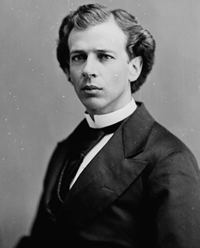Canada's electoral history from 1867 to today
And they keep winning, and winning, and winning!
by Maurice Y. Michaud (he/him)
Introducing the most elected person in Canada!
You might be thinking to yourself, "If that's the case, why have I never seen this man?" But you have, since he has been on multiple versions of the Canadian five dollar bill since 1972. You are simply not used to seeing Canada's seventh prime minister, Wilfrid Laurier, when he was still 22 years away from becoming the head of government. (By the way, he will be losing his place on our currency later in the 2020s.)
Indeed, this photo was taken in 1874, the year he began his first term as the federal member for Drummond—Arthabaska. From 1867 to the early 1870s, politicians were allowed to sit in both the federal and provincial legislatures in what was known as the "double mandate," but given that the practice was abolished in Québec starting in 1874, Laurier cut short his first and only term at the legislative assembly in which he represented that same riding provincially for two-and-a-half years.
He ran 21 times and won 18 of those races, but that impressive record is misleading for two reasons.
- A member who was being appointed to the cabinet for the first time had to resign his seat and win it back in a ministerial by-election. As successful as Laurier's electoral record eventually became, at the time he was one of the rare ones to lose such a by-election, so he had to run in another one a month later to gain back a seat in the Commons, which he did in Québec East instead of Drummond—Arthabaska on November 28, 1877. In other words, three of his races were in by-elections that were mere formalities normally won with little or no opposition.
- While the double mandate had been abolished, a man — because they were all men at that time — could run in more than one riding in the same general election to ensure he would not find himself without a seat. After bitterly discovering how easily that could happen, Laurier "double ran" in 1896, 1904, 1908, and 1911. Usually, if a man won more than one seat, he would select one to keep. However, after his 1908 double run, Laurier continued to sit for the City of Ottawa riding for a year while sitting for Québec East, and, after the 1911 general election, he sat for both Soulanges and Québec East for the entire six years of the 12th Parliament from 1911 to 1917.
Taking into account his 7 years, 7 months and 20 days of overlaps, he served as a parliamentarian for 44 years, 11 months and 7 days, and
died in office as the leader of the Official Opposition on February 17, 1919, at the age of 77.
© 2019, 2024 :: PoliCan.ca (
Maurice Y. Michaud)
Pub.: 17 Jun 2022 22:09
Rev.: 13 Nov 2023 00:06 (but data presented dynamically)


